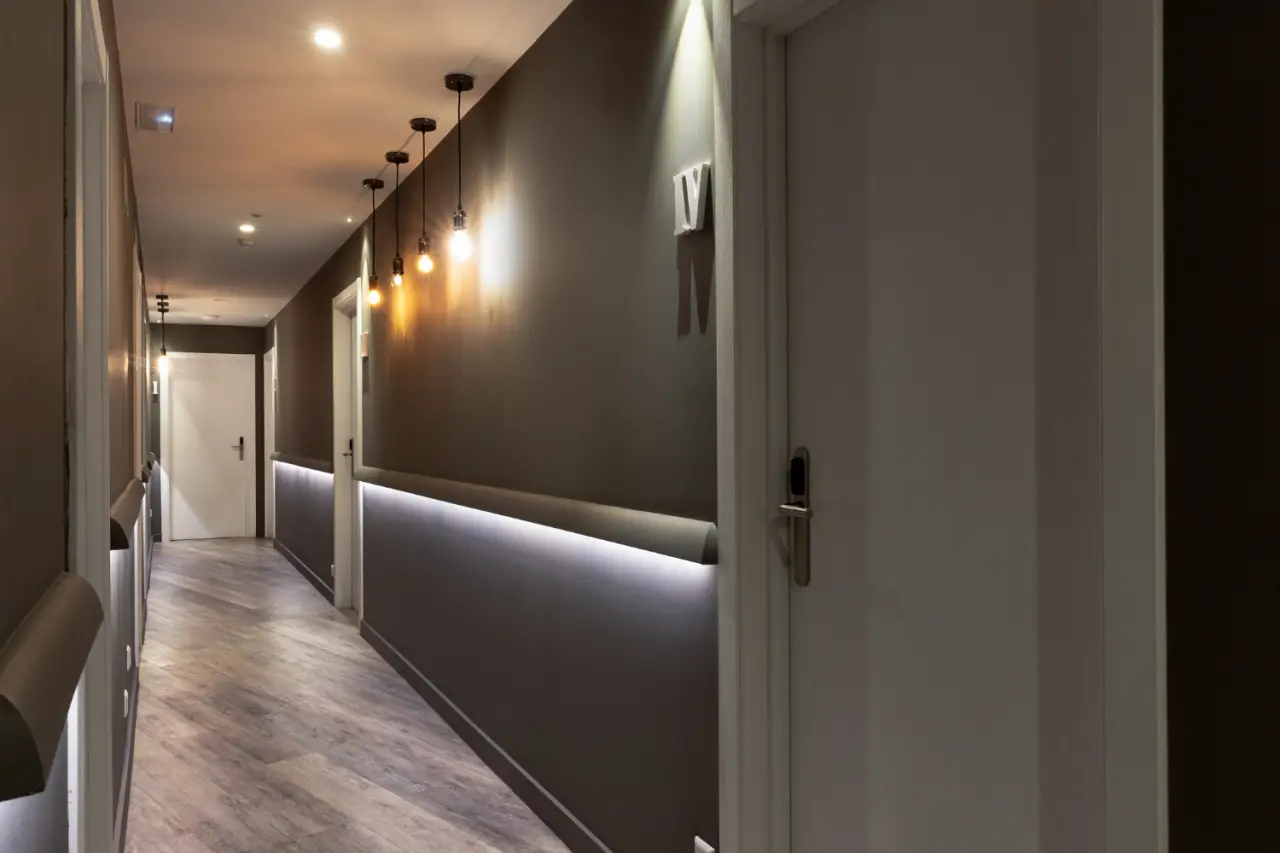Adjoining Rooms
What is An Adjoining Room?
An adjoining room refers to two separate hotel rooms that are located next to each other, sharing a common wall but without a door connecting them directly inside.
What is the difference between Adjoining Rooms and Connecting Rooms?
The difference between adjoining rooms and connecting rooms lies in their layout and access points, catering to various preferences for privacy and convenience among travelers.
Adjoining Rooms are two separate hotel rooms located next to each other, sharing a common wall. However, they do not have a direct internal door connecting them. This setup is ideal for travelers who wish to stay close to each other while still maintaining a level of privacy and separation. Adjoining rooms are often requested by groups or families who need multiple rooms but want the convenience of proximity.
Connecting Rooms, on the other hand, are a pair of rooms that not only share a common wall but also have a door inside that connects them directly. This arrangement allows guests to move freely between the two rooms without having to step out into the public hallway, providing a balance of togetherness and privacy. Connecting rooms are particularly popular among families with children or groups who prefer easy access to each other’s spaces while retaining the option to close the door for private moments.
In short, the main difference is that adjoining rooms are close but separated by a wall without internal access, while connecting rooms are linked by an internal door, offering a seamless transition from one space to another.
How do I request Adjoining and/or Connecting Rooms?
Early Request: Much like securing the best spot at a picnic, the earlier you request, the better your chances. As soon as you know your travel dates, reach out to the hotel to make your request.
Direct Communication with the Hotel: Initiating direct contact with the hotel via telephone or email is highly effective. This allows for the articulation of your specific requirement for adjoining rooms, ensuring the hotel staff understands the nature of your request. It is recommended to provide comprehensive details, including the names of all parties involved and any preferences regarding room types or locations within the hotel.
Online Booking Notes: If reserving your accommodations through an online booking platform, utilize any available section for special requests to indicate your preference for adjoining rooms. While this method communicates your needs, it is less direct than speaking with hotel personnel, and follow-up communication may be necessary to confirm the request.
Travel Agent Services: Engaging a travel agent offers another avenue for securing adjoining rooms. Experienced agents are familiar with the process and can liaise with the hotel on your behalf, often leveraging professional relationships to accommodate your needs.
Confirmation and Follow-Up: Regardless of the method utilized to request adjoining rooms, it is imperative to obtain confirmation from the hotel. This may come in the form of an email or a note on your reservation. Close to your arrival date, a follow-up communication is advisable to reconfirm your request, ensuring that your accommodations are arranged as per your specifications upon check-in.
Check the hotels’ help pages, many hotels like Marriott, offers guidance.
Advantages of Adjoining Rooms
1. Privacy and Proximity: Adjoining and connecting rooms offer the perfect balance between privacy and closeness. They are ideal for travelers who want to stay near each other while also having their own space, such as families with older children or groups of friends.
2. Flexibility in Accommodation: These room types cater to various group sizes and dynamics, providing flexibility in accommodation options. Families can easily supervise children, and groups can enjoy shared spaces without compromising privacy.
3. Enhanced Group Experience: Adjoining or connecting rooms enhance the social aspect of traveling together. They facilitate easy communication and planning, making them perfect for coordinating activities or simply enjoying each other’s company.
4. Convenience: These rooms offer convenience, especially for families needing to manage nap times for kids or groups with different schedules. The ease of moving between rooms without accessing public corridors is particularly beneficial.
5. Security: For families, the ability to have children in an adjoining or connected room provides a sense of security. Parents can easily check on their children without leaving their room.
Disadvantages of Adjoining Rooms
1. Limited Availability: Not all hotels offer adjoining or connecting rooms, and even when they do, availability can be limited. This can make securing these rooms, especially during peak travel seasons, challenging.
2. Higher Cost: Depending on the hotel’s pricing structure, booking adjoining or connecting rooms can be more expensive than reserving a single larger suite. The cost may also vary significantly based on demand, season, and the hotel’s policies.
3. No Guarantee: Many hotels cannot guarantee adjoining or connecting rooms at the time of booking due to operational constraints. Confirmation is often only possible at check-in, which can be inconvenient for travelers with specific needs.
4. Potential for Noise Transfer: Sharing a common wall (in adjoining rooms) or having an internal door (in connecting rooms) can sometimes lead to increased noise transfer between the rooms, which might affect privacy and relaxation.
5. Miscommunication or Booking Errors: There’s a risk of miscommunication or errors during booking, especially if requests for adjoining or connecting rooms are not clearly stated or understood by the hotel staff. This could lead to accommodations that do not meet the traveler’s needs or expectations.
Understanding these advantages and disadvantages helps travelers weigh their options and make informed decisions when booking accommodations for groups or family travel, ensuring their needs and preferences are adequately met.
Previous Term: Add-on
Next Term: Adoption Rate
A | B | C | D | E | F | G | H | I | J | K | L | M | N | O | P | Q | R | S | T | U | V | W | Y | Z

